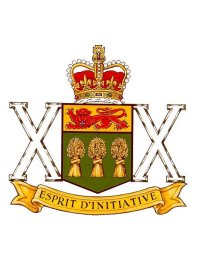The Saskatchewan Dragoons
| The Saskatchewan Dragoons | |
|---|---|

The Saskatchewan Dragoons badge
|
|
| Active | 1913–present |
| Country |
|
| Branch | Army, Primary Reserve (Militia) |
| Type | Armoured reconnaissance |
| Size | One squadron |
| Part of | 38 Canadian Brigade Group |
| Garrison/HQ | LCol D.V. Currie, VC Armoury Moose Jaw, Saskatchewan |
| Motto(s) | French: Esprit d'initiative "Spirit of initiative" |
| March | "Punjaub" |
| Battle honours |
|
| Website | Saskatchewan Dragoons |
| Commanders | |
| Colonel-in-Chief | Prince Edward, Earl of Wessex |
The Saskatchewan Dragoons is a Primary Reserve armoured regiment of the Canadian Army. The unit is based in Moose Jaw. Their primary job is to assist the Regular Force in meeting Canada's military commitments. Their training and equipment closely follow that of the Regular Force, which the Reserves are called upon to assist increasingly often. The Saskatchewan Dragoons are part of 3rd Canadian Division's 38 Canadian Brigade Group.
Prince Edward, Earl of Wessex, became colonel-in-chief of the regiment on visiting Saskatchewan in 2003, when he congratulated the regiment on its "contribution to Canada's proud tradition of citizen-soldiers in the community". Involved in peacekeeping operations in Cyprus, the Golan Heights, Bosnia and Croatia, members of the regiment have also provided aid during floods and forest fires in the prairies.
Their role is that of a reconnaissance squadron. They examine an area in preparation for the advance of a main body of troops. They go forward, sometimes many miles, and gather information on enemy strength, equipment, movements, and intentions. They pass this information, together with other helpful information on such things as bridges, blocked roads, and areas of potential danger, back to higher command so the advance can take place as safely as possible. At the same time they deny such information to the enemy. In the withdrawal, they maintain contact with the enemy while the main body pulls back. Thus, they often speak of their role as "first in last out".
The Saskatchewan Dragoons perpetuate the 46 Battalion (South Saskatchwewan), CEF and the 128th Battalion (Moose Jaw), CEF.
The Saskatchewan Dragoons originated in Regina, Saskatchewan on 3 July 1905, when a regiment of infantry was authorized to be formed in the districts of Assiniboia and Saskatchewan. It was designated the 95th Regiment on 2 April 1907 and the 95th Saskatchewan Rifles on 1 June 1909. On 1 April 1912 the regiment was reorganized as two separate regiments, the 105th Regiment (now The North Saskatchewan Regiment) and the 95th Saskatchewan Rifles. On 15 March 1920, it was amalgamated with the 60th Rifles of Canada and redesignated The South Saskatchewan Regiment. On 15 May 1924, The South Saskatchewan Regiment was reorganized into five separate regiments, The Assiniboia Regiment (now the 10th Field Artillery Regiment, RCA), The Regina Rifle Regiment (now The Royal Regina Rifles), The Weyburn Regiment (now The South Saskatchewan Regiment), The Saskatchewan Border Regiment (now The South Saskatchewan Regiment) and The South Saskatchewan Regiment. It was redesignated The King's Own Rifles of Canada on 15 September 1924. On 15 December 1936, it was amalgamated with B Company of the 12th Machine Gun Battalion, CMGC (now The Royal Regina Rifles) and redesignated The King's Own Rifles of Canada (MG). It was redesignated the 2nd Battalion, The King's Own Rifles of Canada on 29 January 1942 and, upon conversion to armour, the 20th (Saskatchewan) Armoured Regiment, RCAC, on 1 April 1946, the 20th Saskatchewan Armoured Regiment on 4 February 1949, The Saskatchewan Dragoons (20th Armoured Regiment) on 31 July 1954 and The Saskatchewan Dragoons on 19 May 1958.
...
Wikipedia
